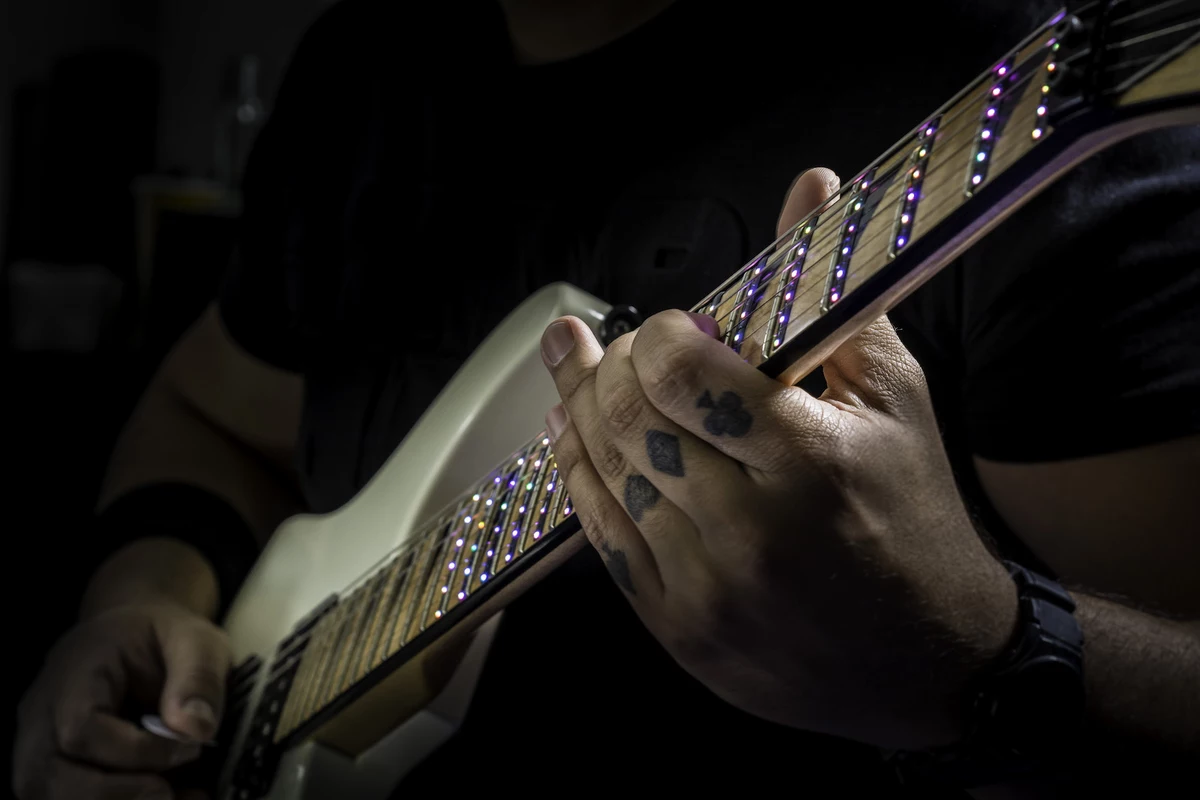Any rock fan who’s ever picked up an electric guitar has probably dreamed of becoming the next Eddie Van Halen, Jimmy Page, Nancy Wilson or Slash. But if you’re going to become a guitar hero, you’ve got to learn the basics first.
That’s where Fret Zealot comes in. With Fret Zealot, guitarists can learn how to intuitively play songs in their entirety, rather than one note or chord at a time. They can also take detailed guitar lessons and learn beginner and advanced techniques instinctively. The platform features over 3,000 lessons, over 100 courses, 80,000 song tabs, every chord and scale, 60 alternate tunings and more. After playing a note, the Fret Zealot app detects the sound and lights up where the fingers go next.
There is also an optional guitar instructional tool: an LED strip that fits just above the frets on their own guitar, showing the guitarist exactly where to put their fingers to play. The multi color LEDs sync live with videos and information on screen via Bluetooth.
Now, look: We know you’re ready to rig up your guitar with your LED system and start playing “Hot for Teacher” and “Enter Sandman.” But as you learn how to play these songs with Fret Zealot, it helps to familiarize yourself with your instrument and understand what techniques you’re incorporating into your playing. Here are 15 guitar terms that every player should know.
Alternate picking: Picking in opposite directions (up and down).
Arpeggio: The individual notes of a chord played in succession, typically in ascending or descending order.
Bend: Pushing or pulling a string up or down across a fret to raise the pitch of a note, typically done in half- or full-tone intervals.
Dropped-D tuning: Lowering the sixth string on your guitar one whole tone, from E to D (in standard tuning). Great for crushing breakdowns, or playing power chords with just one finger.
Hammer-on: Sounding a note by firmly pressing down or “hammering” on a string using a fretting-hand finger.
Harmonic: Amplified overtones that can be produced multiple ways:
Natural harmonic: touch the string directly above the fret and pluck the string hard with your picking hand.
Artificial harmonic: Touching a string with the index finger of your picking hand 12 frets higher than any fretted note, and plucking the string with another finger on your picking hand (typically either the thumb, third or fourth finger).
Pinch harmonics: Harmonics produced by plucking the string and having the string immediately bounce off the thumb. Accomplished by holding the pick with the thumb closer to the edge of it. Pinch harmonic “squeals” are the stock-in-trade of players like Zakk Wylde, Eddie Van Halen and Dimebag Darrell.
Tapped harmonics: A combination of harmonics and tapping. Pluck a note, then use a finger on your picking hand to tap the same string directly above the fret that’s 12 frets up from the fundamental note. (Ex. If you’re holding down the seventh fret on the G string, you would tap the G string right above the 19th fret.)
Open tuning: Tuning the guitar differently from the “standard” EADGBE low-to-high tuning so that strumming all six strings without fingering any of them produces a major or minor chord.
Palm mute: Placing the side of your picking hand closest to the guitar lightly across the strings to produce a damping effect while picking. Commonly used in hard rock and metal to create a “chugging” sound.
Power chord: A truncated chord consisting of the root note, the fifth and possibly the octave of the root. Used in countless rock and metal songs, including Black Sabbath’s “Iron Man” to Nirvana’s “Smells Like Teen Spirit.”
Pull-off: The opposite of a hammer-on; plucking a note with a finger on a higher fret, then pulling finger off to sound a lower note on the same string.
Slide: Striking a note and sliding the fretting finger up or down the neck to a different fret, creating a glissando effect. Can also be done with a glass, plastic or metal tube placed on the third or fourth finger.
Standard tuning: On a regular six-string guitar, standard tuning is EADGBE, low to high.
Tapping: Sounding notes on a guitar by simply tapping a string at any fret, rather than plucking a string. Can be done with one or both hands at the same time. The technique was popularized in the late ‘70s by Eddie Van Halen and was prevalent throughout the ‘80s.
Tremolo: A wavering or “shuddering” effect in musical tone achieved by rapidly picking or plucking a note in a down-up pattern.
Vibrato: A rapid, slight variation in pitch achieved by pushing a string up and down on the fretboard. Can also be achieved using a vibrato system, commonly referred to as a whammy bar.

